
Artemisia is a large, diverse genus of plants belonging to the daisy family Asteraceae, with between 200 and 400 species. Common names for various species in the genus include mugwort, wormwood, and sagebrush.
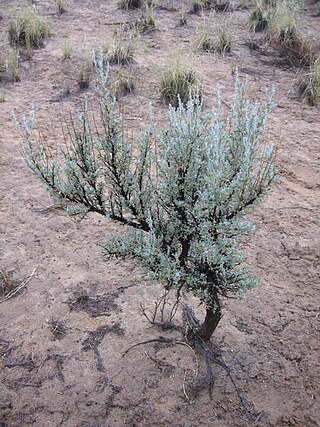
Artemisia tridentata, commonly called big sagebrush, Great Basin sagebrush or (locally) simply sagebrush, is an aromatic shrub from the family Asteraceae, which grows in arid and semi-arid conditions, throughout a range of cold desert, steppe, and mountain habitats in the Intermountain West of North America. The vernacular name "sagebrush" is also used for several related members of the genus Artemisia, such as California sagebrush.

Shrub-steppe is a type of low-rainfall natural grassland. While arid, shrub-steppes have sufficient moisture to support a cover of perennial grasses or shrubs, a feature which distinguishes them from deserts.

Artemisia arbuscula is a North American species of sagebrush known by the common names little sagebrush, low sagebrush, or black sagebrush. It is native to the western United States from Washington, Oregon, and California east as far as Colorado and Wyoming. It grows in open, exposed habitat on dry, sterile soils high in rock and clay content.

Artemisia bigelovii is a North American species of sagebrush known by the common name Bigelow sagebrush or flat sagebrush. It grows in the deserts of the southwestern United States.

Artemisia nova is a North American species of sagebrush, known by the common name black sagebrush. It is "one of the most common shrubs in the western United States".

Artemisia spinescens is a North American species of sagebrush in the sunflower family, known by the common name budsage.

Astragalus purshii is a species of milkvetch known by the common names woollypod milkvetch and Pursh's milkvetch.

Sagebrush is the common name of several woody and herbaceous species of plants in the genus Artemisia. The best known sagebrush is the shrub Artemisia tridentata. Sagebrushes are native to the North American west.

Nestotus stenophyllus is a species of flowering plant in the family Asteraceae known by the common name narrowleaf mock goldenweed. It was previously known as Stenotus stenophyllus. It is native to the western United States, especially the inland Pacific Northwest and northern Great Basin, where it grows in sagebrush habitat usually in rocky soil.

Lomatium ochocense is a rare species of flowering plant in the carrot family known by the common name Ochoco lomatium. It is endemic to Oregon, where it is limited to the Ochoco Mountains of Crook County.
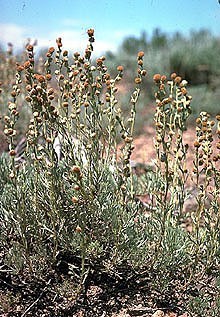
Artemisia papposa is a species of flowering plant in the aster family known by the common names Owyhee sage, Owyhee sagebrush, and fuzzy sagebrush. It is native to the Snake River Plain and surrounding areas in the northwestern United States, occurring in southern Idaho, eastern Oregon, and northern Nevada.

Artemisia filifolia, known by common names including sand sagebrush, sand sage and sandhill sage, is a species of flowering plant in the aster family. It is native to North America, where it occurs from Nevada east to South Dakota and from there south to Arizona, Chihuahua, and Texas.
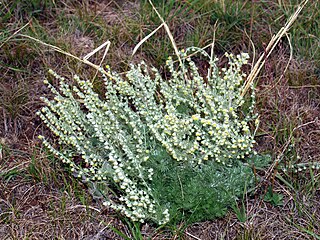
Artemisia frigida is a widespread species of flowering plant in the aster family, which is known as the sunflower family. It is native to Europe, Asia, and much of North America. In parts of the north-central and northeastern United States it is an introduced species.

Artemisia pedatifida is a species of flowering plant in the aster family known by the common names birdfoot sagebrush and matted sagewort. It is native to a section of the west-central United States encompassing parts of Idaho, Montana, Wyoming and Colorado, where it occurs on the high plains.
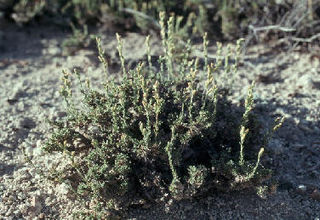
Artemisia pygmaea is a North American species of sagebrush in the aster family known by the common name pygmy sagebrush.
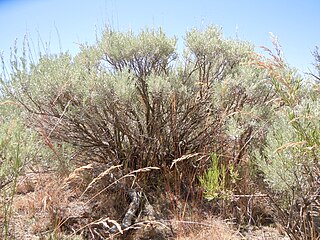
Artemisia tripartita is a species of flowering plant in the aster family known by the common name threetip sagebrush. It is native to western North America from British Columbia to Nevada and Montana to Colorado. It covers about 8.4 million acres of the Rocky Mountains and Great Basin.
Astragalus anisus is a species of flowering plant in the legume family known by the common name Gunnison milkvetch. It is endemic to Colorado in the United States, where it is limited to the Gunnison Basin of Gunnison and Saguache Counties.
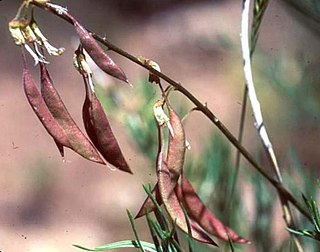
Astragalus ripleyi is a species of flowering plant in the legume family known by the common name Ripley's milkvetch. It is native to southern Colorado and northern New Mexico in the United States.

Phlox douglasii, common name tufted phlox or Columbia phlox, is a species of perennial herb belonging to the family Polemoniaceae. In the past it has been mistakenly included within the species Phlox caespitosa.



















